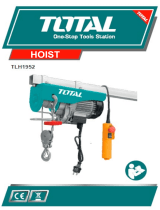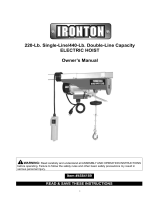
8DO NOT allow a raised and supported load to fall and thus shock load the mounting, hoist, cable and hook.
8DO NOT use more than one hoist to lift a load.
8DO NOT leave the hoist unattended with a suspended load.
8DO NOT wrap the hoist cable around the load.
8DO NOT use the hoist to lift dangerous materials.
8DO NOT use the hoist to lift people.
9Use a qualied person to lubricate and maintain the hoist.
9When not in use and before carrying out repairs/maintenance isolate the hoist from the power supply.
▲DANGER! Ensure that personnel are prevented from passing beneath the hoist and load.
2. INTRODUCTION
Approved to EU and UK Lifting Gear Regulations. These hoists are intended for use where a suitable support facility exists. Support brackets
are included with the equipment.
The support bar is not included.
3. SPECIFICATION
Model no ...............................................PH250.V4/PH400.V3
Capacity double cable ........................................250kg/400kg
Capacity single cable .........................................125kg/200kg
Current ....................................................................2.2A/3.3A
Group of mechanisms ....................................................... M1
Lift height double cable ..................................................... 6m
Lift height single cable..................................................... 12m
Lift speed (max). ........................................................ 8m/min
Minimum rope tensile strength ......... 1870N/mm²/1770N/mm²
Motor power ........................................................500W/750W
Power Supply Cable Length: .......................................... 1.3m
Rope diameter ................................................... 3mm/3.8mm
Voltage ................................................................ 230V~50Hz
Work rate ...........................................................................S3
4. MOUNTING
4.1. Unpack the hoist and check contents against the items listed below.
Should there be any damaged or missing parts contact your supplier immediately.
Contents
1. Hoist assembly.
2. Double line pulley and hook (loosely assembled).
3. Four each of: bolts, spring washers and washers.
4. Two mounting brackets.
4.2. Ensure that the selected hoist support is sufciently strong and will also hold
the hoist in a horizontal position. If alternative mounting brackets are fabricated,
ensure that these are at least as strong as those provided, and align with the
mounting holes (g.1.A) in the hoist.
5. OPERATION
WARNING! Before using the hoist ensure that you have read, understood and
apply the safety instructions in Section 1.
IMPORTANT: In an emergency press the emergency stop button to halt the
hoist (g.2.7), to release the emergency stop button, turn it clockwise.
5.1. Ensure that the load to be lifted is directly below the hoist and that any lifting
straps, ropes or chains being used are capable of supporting the weight.
5.2. With mains power switched on, operate control switch (g.2.1) to bring hook to
load height. Press lower half of switch to lower hook and upper half to raise hook.
Release switch to stop hoist.
5.3. Attach hoist hook (g.2.2) to load, ensuring that safety bar (g.2.3) is fully closed.
5.4. Use control switch (g.2.1) to raise or lower the load to the required height.
5.5. To carry out a double line lift, rst hook the single line hook in aperture in hoist
frame (g.3.1). Then take double line pulley and hook (g.3.2), remove ‘R’ pin,
shaft and washers and undo nyloc nuts and remove small bolts (g.3.3). Place
pulley on cable loop between hoist drum and single line hook. Replace hook and
ret shaft,washers and ‘R’ pin, then ret small bolts and tighten the nyloc nuts on
them. Ensure that pulley is free to rotate. Proceed as above in 5.1. to 5.4.
Notes: 1. It is important not to completely empty the cable drum, it is designed
so that if the cable is run out to it’s end, the cable will engage with the safety
bar (g.2.6) and cut the motor out, and there will still be sufcient windings on
the drum. If however the cable is being pulled out of the hoist at an angle, it
may not engage with the safety bar, so caution is needed in this situation.
2. In order to prevent the motor/gearbox from overheating, the hoist should
not be operated for longer than four minutes at any one time. Any period of use
should be followed by a similar period with the hoist at rest.
3. Do not wind loose cable onto drum - ensure that cable is always under tension.
g.1
g.2
g.3
Original Language Version
© Jack Sealey Limited PH250.V4, PH400.V3 Issue 4 (1) 03/03/23






